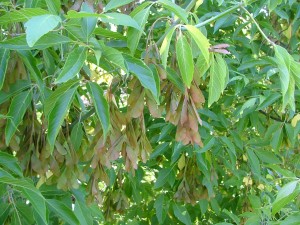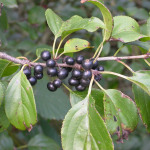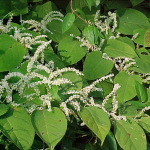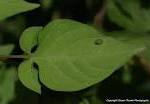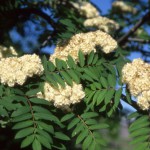“A landscape populated by nonnative plants is, for wildlife, the equivalent of a desert.” – Margaret Renkl, The Real Aliens in Our Backyard
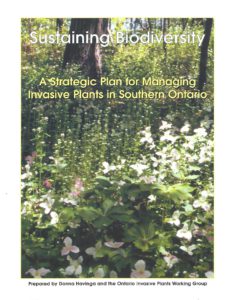
Read more on invasive plants: Sustaining Biodiversity – A Strategic Plan for Managing Invasive Plants in Southern Ontario
Below are some of the invasive exotic species found in southern Ontario, according to observations from UFORA and our colleagues.
We use four categories to sort invasive species based on their greatest negative effect to local ecosystems.
The term “invades” refers to exotic species that become significant in a new area; “dominates” means that the species excludes most others; “native” is the same as indigenous.
Species marked with an (*) may be native to parts of Ontario, but they display aggressive behaviour that threatens natural biodiversity in certain areas, usually aided by human activities.
They are considered invasive exotic plants outside their natural range. We are in the process of revising this list for the Invasive Species Centre. We’ll post the new list when it’s finished.
——————————————————————————————————————————————————————————————-
Common Buckthorn
Category 1
Aggressive invasive exotic species that can dominate a site to exclude all other species and remain dominant on the site indefinitely.These are a threat to natural areas wherever they occur because they can reproduce by means that allow them to move long distances. Many of these are dispersed by birds, wind, water or vegetative reproduction. These are the top priority for control, but control may be difficult. Eradication may be the only option for long-term success.
Common Name Scientific Name Effect on Natural Area Amur honeysuckle Lonicera maackii invades meadows & forest edges Autumn olive Elaeagnus umbellata dominates forest edges Black alder Alnus glutinosa dominates wetlands, changes by shading Black swallow-wort Cynanchum nigrum dominates meadows & forest understory Canada thistle Cirsium arvense dominates meadows, prairies & forest edges Common buckthorn Rhamnus cathartica dominates understory, meadows & prairies Common reed Phragmites australis * dominates wetlands & wet meadows Crown vetch Coronilla varia dominates disturbed meadows Curly pondweed Potamogeton crispus dominates open water areas in SW Ontario Dames rocket Hesperis matronalis dominates open understory & meadows Eur . fly honeysuckle Lonicera xylosteum invades meadows & forest edges Eurasian water milfoil Myriophyllum spicatum dominates open water habitats European birch Betula pendula dominates wetlands, changes by shading European frog-bit Hydrocharis morsus-ranae dominates open water habitats Floating heart Nymphoides peltatum dominates open water habitats Flowering rush Butomus umbellatus dominates open marshes Garlic mustard Alliaria petiolata dominates forest herb layer Glossy buckthorn Rhamnus frangula dominates wetlands Goutweed Aegopodium podagraria dominates forest understory Himalayan balsam Impatiens glandulifera dominates forests & wet meadows Japanese honeysuckle Lonicera japonica dominates forest understory in northern US Manitoba maple Acer negundo * aggressively invades all habitat types Morrow’s honeysuckle Lonicera morrowi invades meadows & forest edges Multiflora rose Rosa multiflora dominates forest edges Pale swallow-wort Cynanchum rossicum dominates meadows & forest understory Purple loosestrife Lythrum salicaria dominates wetlands Rough manna grass Glyceria maxima dominates wet meadows Tartarian honeysuckle Lonicera tatarica invades meadows & forest edges White mulberry Morus alba hybridizes with rare M. rubra ———————————————————————————————————————————————————–
Japanese Knotweed
Category 2
Exotic species that are highly invasive but tend to only dominate certain niches or do not spread rapidly from major concentrations.Many of these spread vegetatively, or by seeds that drop close to the parent plant. They may have been deliberately planted and persist in dense populations for long periods.
Control where necessary and limit their spread to other areas.
Common Name Scientific Name Effect on Natural Area Bird-foot trefoil Lotus corniculatus dominates meadows & prairies Black locust Robinia pseudo-acacia invades meadows Cow vetch Vicia cracca dominates meadows & prairies Japanese knotweed Polygonum cuspidatum dominates wet meadows & moist forests Kentucky bluegrass Poa pratensis dominates prairies Lilac Syringa vulgaris dominates shallow limestone areas Moneywort Lysimachia nummularia dominates wet forest understory Mossy stonecrop Sedum acre invades alvars Norway maple Acer platanoides dominates forest canopy Oriental bittersweet Celastrus orbiculatus dominates forests and forest edges Periwinkle Vinca minor dominates forest understory Scilla Scilla siberica dominates in forest understory Scots pine Pinus sylvestris invades meadows Siberian elm Ulmus pumila invades prairies, causes changes by shading Sycamore maple Acer pseudoplatanus dominates forest canopy Tree of Heaven Ailanthus altissima replaces native early-successional forest White bedstraw Galium mollugo invades meadows White poplar Populus alba invades meadows White sweet-clover Melilotus alba dominates meadows & prairies Yellow sweet-clover Melilotus officinalis dominates meadows & prairies ———————————————————————————————————————————————————–
Bittersweet Nightshade
Category 3
Exotic species that are moderately invasive but can become locally dominant when the proper conditions exist.Control where necessary and limit their spread to other areas.
Common Name Scientific Name Effect on Natural Area Absinth sage Artemisia absinthum invades disturbed meadows Bittersweet nightshade Solanum dulcamara invades forests & wetlands Bouncing bet Saponaria officinalis invades meadows Bugleweed Lycopus europaeus invades wetlands, displaces native species Common barberry Berberis vulgaris invades forests Common hawkweed Hieracium vulgatum invades meadows Common vetch Vicia sativa invades meadows Crack willow Salix fragilis invades wetlands, displaces willows Creeping buttercup Ranunculus repens invades meadows Creeping thyme Thymus praecox invades meadows Cypress spurge Euphorbia cyparissias invades meadows English ivy Hedera helix invades forest understory Eulalia Miscanthus sinensis dominates wet meadows European stinging nettle Urtica dioica ssp . dioica dominates forest understory False spiraea Sorbaria sorbifolia invades meadows & forest understory Field bindweed Convolvulus arvensis dominates meadows Hoary-alyssum Berteroa incana invades prairies Horse-chestnut Aesculus hippocastanum creates dense shade Hybrid willow Salix x rubens invades wetlands, displaces willows Japanese barberry Berberis thunbergii invades forests Japanese hop Humulus japonicus invades wet meadows Lily-of-the-valley Convallaria majalis frequently escapes garden for forests Marsh cress Rorippa amphibia invades wetlands in SE Ontario Mother-of-thyme Acinos arvensis invades alvar habitats Nodding thistle Carduus nutans invades meadows & prairies Orange hawkweed Hieracium aurantiacum invades meadows Orchard grass Dactylis glomerata invades meadows & prairies Pale hawkweed Hieracium x floribundum invades meadows Quack grass Elymus repens dominates meadows & prairies Russian olive Elaeagnus angustifolia invades meadows & shrub communities Singleseed hawthorn Crataegus monogyna dominates shrubs in meadows & prairies Slender vetch Vicia tetrasperma invades meadows Spindle-tree Euonymus europaeus invades forest understory & edges Spotted knapweed Centaurea maculosa invades meadows & prairies Summer cypress Kochia scoparia invades meadows Tall fescue Festuca arundinacea dominates moist meadows & prairies Tansy Tanacetum vulgare invades disturbed meadows Teasel Dipsacus sylvestris dominates meadows & prairies Velvet-leaf Abutilon theophrasti invades meadows White willow Salix alba invades wetlands, displaces willows Wild parsnip Pastinaca sativa invades meadows Winged euonymus Euonymus alata invades forest understory shrub layer Yellow bedstraw Galium verum invades meadows & prairies Yellow hawkweed Hieracium caespitosum invades meadows Yellow rocket Barbarea vulgaris invades meadows ———————————————————————————————————————————————————–
European Mountain-Ash
Category 4
Exotic species that do not pose a serious threat to natural areas unless they are competing directly with more desirable vegetation.These can often be tolerated in restoration projects if they are already present. They may eventually be replaced through natural succession or management.
Control where necessary and limit their spread to other areas.
Common Name Scientific Name Effect on Natural Area Alfalfa Medicago sativa invades meadows & prairies Amur maple Acer ginnala frequently planted Black medick Medicago lupulina invades meadows Butter-and-eggs Linaria vulgaris invades meadows Carolina poplar Populus x canadensis frequently misidentified Catnip Nepeta cataria invades meadows Creeping bellflower Campanula rapunculoides invades forest edges & meadows Creeping bugleweed Ajuga reptans persists in forest understory & edges Elecampane Inula helenium invades meadows European Mountain-ash Sorbus aucuparia invades forests Foxtail grasses Setaria sp. invades meadows Goat willow Salix caprea frequently substituted for S. discolor Ground ivy Glechoma hederacea competes with meadow & prairie species Guelder rose Viburnum opulus ssp. opulus replaced cranberry bushes in S. Ontario Japanese spurge Pachysandra terminalis persists in forest understory & edges Leafy spurge Euphorbia esula can dominate prairies Musk mallow Malva moschata invades meadows Orange Day lily Hemerocallis fulva dominates meadows Peppermint Mentha x piperita invades meadows Perennial rye grass Lolium perenne competes with meadow & prairie species Privet Ligustrum vulgare invades forest edges Purple willow Salix purpurea invades wetlands Rabbit-foot clover Trifolium arvense invades meadows Red clover Trifolium pratense invades meadows Scotch elm Ulmus glabra invades disturbed forests Sheep sorrel Rumex acetosella invades meadows Smooth brome Bromus inermis resists conversion to native meadow & prairie St. John’s wort Hypericum perforatum can dominate meadows Sweet coltsfoot Tussilago farfara invades wet meadows & riverbanks Tansy groundsel Senecio jacobaea invades meadows True forget-me-not Myosotis scorpioides dominates shaded seepage areas Western snowberry Symphoricarpus albus var laevigatus frequently misidentified White clover Trifolium repens invades meadows Wild marjoram Origanum vulgare invades disturbed meadows Yellow flag Iris pseudacorus invades wetlands ———————————————————————————————————————————————————–
Common Hop
Potentially Invasive Exotic Species to Monitor
Some of these species have the potential to become invasive exotics in Ontario.They can reproduce aggressively on occasion but have not been shown to be a serious threat to natural areas in the province.
Some are very similar to indigenous species and could simply have been overlooked.
Common Name Scientific Name Risk to Natural Areas Bird cherry Prunus avium does not dominate natural areas Common hop Humulus lupulus locally invasive in Ontario Common mugwort Artemisia vulgaris highly invasive in NYC natural areas Dyer’s woad Isatis tinctoria new invader to Bruce Peninsula European ash Fraxinus excelsior sometimes misidentified as Black ash European aspen Populus tremula very similar to Bigtooth aspen European linden Tilia cordata does not dominate natural areas European red elder Sambucus racemosa often misidentified as American red elder European white alder Alnus incana ssp. incana often misidentified as Speckled alder Exotic cattail species Typha sp. sold in nurseries in northeast US Fanwort Cabomba caroliniana invasive in New England lakes Hydrilla Hydrilla verticillata invasive in mid-Atlantic US states Mezer’s Daphne Daphne mezereum has invaded moist forests in S. Ontario Minor naiad Najas minor invasive in waterways in US northeast Nipplewort Lapsana communis Perfumed cherry Prunus mahaleb Porcelain-berry Ampelopsis brevipedunculata invasive in northeast US Red osier dogwood Cornus sericea confusion with Eurasian red dogwoods Reed canary grass Phalaris arundinacea* European strain may dominate wet meadows Sweet violet Viola odorata very aggressive garden plant Water-chestnut Trapa natans invasive in mid-Atlantic US states Waterweed Egeria densa invasive in Massachusetts wetlands

